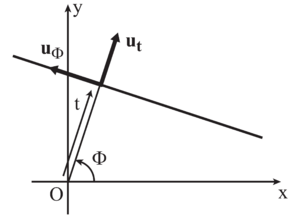T-I-3draft
Radon transform and X-ray tomography
The goal of this homework is to introduce the Radon transform of a two-dimensional function. We will show that this transform is invertible and the inverse involves the Fourier transform in two dimensions. From a practical point of view, the Radon transform is the basis of X-ray tomography (as well as X-ray scanning), applied in the medical context in order to obtain cross-section images of different organs. The second part of the homework consists of a documentation work to be conducted in pairs: each pair of students should prepare a blackboard presentation of approximately five minutes on this part.
Radon transform
Preliminaries: parametrisation of a line in the plane
Q1: In a two-dimensional space, how many parameters are needed in order to define a line? Provide some examples of equations that define a unique line in the plane.
Q2: In the context of Radon transform, we choose to define a line via the parameters and , where , as displayed in Figure 1. Each angle is associated to a unique unit vector :
Show that for each given line there exist two possible pairs of values .
Q3: We choose to orient the line positively along the unit vector , defined by:
Show that for each pair there exists one unique oriented line.
Q4: A natural pair of coordinates, associated to the family of lines obtained from a given , is the pair of coordinates of a point in the basis related to the line that passes through that point. Provide the expression for as a function of , as well as the expression for as a function of . Deduce the relation between the surface elements and .
Definition of Radon transform
Definition: The Radon transform of a function is the function defined by the following expression
Use of the distribution: The definition of Radon transform can be elegantly written by means of the Dirac-delta distribution. This formulation provides the advantage of generalising the definition of Radon transform to arbitrary dimension.
Q5: Using the relation
propose a definition of Radon transform in the form of a surface integral.
Q6: Propose a definition of the Radon transform of a function (). Give a geometrical interpretation of the Radon transform in dimension .
From now on, we will always consider the Radon transform in the two-dimensional case .
Some examples
No calculation needed
Q7: In Figure 2, match each image with the corresponding Radon transform. Images represent functions . Specify the meaning of the grey scales in the different figures. Draw the axes on the Radon transforms, knowing that in the images in the direct space (plane ), the origin of axes is located at the center of the figure.
Q8: Indicate (without doing any calculation) the profile of the Radon transform of a constant function on a quasi-point-like support. Similarly, indicate (without any calculation) the profile of the Radon transform of a constant function on a line, and on a line segment.
Hand calculations
Q9: Compute the Radon transform of a constant function on a disc of radius , and null outside.
Q10: Compute the Radon transform of the function .
Expression for radial functions
Q11: Show that in the case of radial function the Radon transform can be written as a simple integral transform of the function .
Principles of X-ray tomography
What are the physical principles underlying X-ray tomography? In particular, we will specify which physical quantity is measured, and which quantity we try to reconstruct in form of an image. We will verify that we can express the measured quantities as a Radon transform of the parameter that we try to image. X-ray tomography is based on the inversion of the Radon transform, knowing how to deduce from a measure of . The following section addresses the principle at the basis of this inversion.
Inversion of the Radon transform
Back-projection formula
Q12: Explain why the following function
obtained via an angular mean of the Radon transform of a function , is likely to resemble to the function . This formula is called back-projection formula.
Figure 3 displays the application of the back-projection formula to the examples that we have previously considered (binary images), as well as to an example from medical imaging context. Does the back-projection formula allow to inverse the Radon transform? Explain.
Projection-slice theorem
Show that, for a given , the one-dimensional Fourier transform of over the variable is equal to the two-dimensional transform of :
or








































